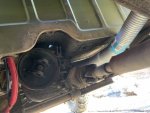I read your post several times and am still confused. You have a 6BT with an automatic in your truck already? If so, then getting a 4 wheel drive automatic and a married NP205 might be your best option. Just a single crossmember for the transmission and transfer case that way.
Everything else being stock going to a NP205 is not that bad but there are a few issues:
U-joint yokes. I think the Dodge version has the same spline count as the NP200 so you can just unbolt and swap them around for a plug and play kind of thing. Otherwise conversion u-joints, expensive yokes or new drive shafts will all have to be figured out and made.
Parking brake. There is no provision on the stock M715 for parking brakes in the axles. Only the transfer case mounted one realistically works. You can take the housing off the NP200 that holds the parking brake, along with the output housing off the NP205 to someone with a lathe/mill and they can cut a very small groove into the NP200 part so it can bolt to the NP205 and then you have a parking brake.
Mounting. The stock NP200 brackets do not bolt to a NP205. You will have to make your own. Some people use the stock cross members and go from there while others just make everything from scratch. There are pictures on this site and the M715 zone of this.
Shift linkage. The NP205 was made for a single shifter. The M715 has 2 shifters for the transfer case. You can remove the shift rails from a NP205 and by cutting small groves at specific points make it a twin stick unit. Searching for NP205 twin stick conversion will tell you all about that.
Finally, I have to ask. Why do you want a NP205? Same low range ratio, same basic case and same basic strength. The only real downside to a NP200 is the whine in a M715 which can be eliminated by doing a center output conversion and the heat created above 48 mph on stock tires for at least 45 minutes of highway cruising. The NP200 is actually sought after by extreme off road rock crawler types because it can be clocked almost straight down for the output shafts.



